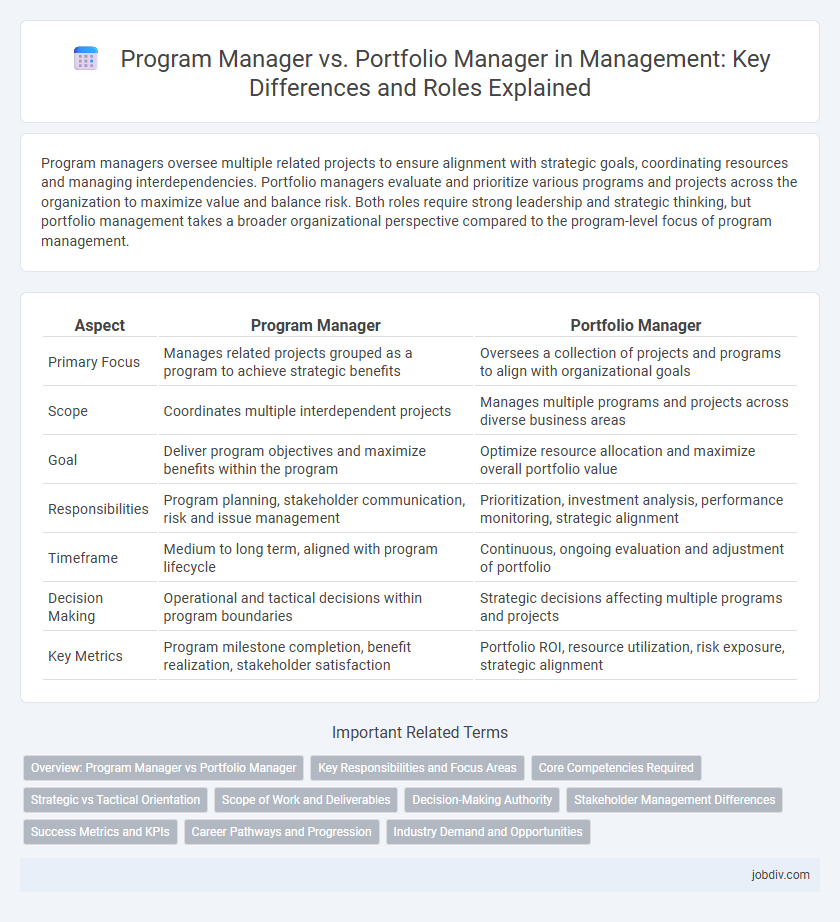Program managers oversee multiple related projects to ensure alignment with strategic goals, coordinating resources and managing interdependencies. Portfolio managers evaluate and prioritize various programs and projects across the organization to maximize value and balance risk. Both roles require strong leadership and strategic thinking, but portfolio management takes a broader organizational perspective compared to the program-level focus of program management.
Table of Comparison
| Aspect | Program Manager | Portfolio Manager |
|---|---|---|
| Primary Focus | Manages related projects grouped as a program to achieve strategic benefits | Oversees a collection of projects and programs to align with organizational goals |
| Scope | Coordinates multiple interdependent projects | Manages multiple programs and projects across diverse business areas |
| Goal | Deliver program objectives and maximize benefits within the program | Optimize resource allocation and maximize overall portfolio value |
| Responsibilities | Program planning, stakeholder communication, risk and issue management | Prioritization, investment analysis, performance monitoring, strategic alignment |
| Timeframe | Medium to long term, aligned with program lifecycle | Continuous, ongoing evaluation and adjustment of portfolio |
| Decision Making | Operational and tactical decisions within program boundaries | Strategic decisions affecting multiple programs and projects |
| Key Metrics | Program milestone completion, benefit realization, stakeholder satisfaction | Portfolio ROI, resource utilization, risk exposure, strategic alignment |
Overview: Program Manager vs Portfolio Manager
Program Managers focus on overseeing related projects aligned to achieve specific business objectives, ensuring coordination, resource allocation, and risk management within the program. Portfolio Managers manage a collection of projects and programs, prioritizing investments based on strategic alignment, resource capacity, and organizational goals to maximize overall value. Both roles require strategic oversight, but Program Managers concentrate on execution within a program while Portfolio Managers emphasize optimizing the project and program mix across the enterprise.
Key Responsibilities and Focus Areas
Program Managers oversee the execution of related projects, ensuring alignment with strategic goals by managing resources, timelines, and stakeholder communication. Portfolio Managers prioritize and select projects or programs based on organizational objectives, balancing risk and investment to maximize value across the entire portfolio. While Program Managers focus on delivering specific program outcomes, Portfolio Managers concentrate on strategic decision-making and resource allocation across multiple programs and projects.
Core Competencies Required
Program Managers excel in coordinating multiple related projects to achieve specific strategic objectives, requiring strong skills in stakeholder communication, risk management, and resource allocation. Portfolio Managers focus on selecting, prioritizing, and governing a collection of projects or programs aligned with organizational goals, demanding expertise in financial acumen, strategic alignment, and performance measurement. Both roles necessitate leadership and decision-making capabilities, but Portfolio Managers emphasize broader strategic oversight while Program Managers prioritize tactical execution.
Strategic vs Tactical Orientation
Program Managers focus on tactical execution by overseeing related projects to achieve specific objectives and deliverables, ensuring alignment with immediate business needs. Portfolio Managers adopt a strategic orientation by prioritizing and balancing multiple programs and projects to maximize overall business value and long-term goals. Strategic decision-making in portfolio management drives resource allocation and risk management across the entire portfolio, while program management emphasizes coordination and integration within program boundaries.
Scope of Work and Deliverables
Program Managers oversee multiple related projects, ensuring coordination, resource allocation, and alignment with strategic objectives to deliver integrated outcomes within a defined scope. Portfolio Managers manage a collection of programs and projects, prioritizing investments and balancing risk to maximize organizational value across diverse business initiatives. Deliverables for Program Managers include cohesive program outputs and benefits realization, while Portfolio Managers deliver strategic investment decisions and performance reporting aligned with business goals.
Decision-Making Authority
Program Managers possess decision-making authority concentrated on coordinating multiple related projects to achieve specific business objectives within a program's scope. Portfolio Managers hold broader decision-making power overseeing a collection of programs and projects, prioritizing resource allocation and strategic alignment with organizational goals. This distinction in authority levels directly impacts how resources are managed and strategic decisions are implemented across the enterprise.
Stakeholder Management Differences
Program Managers engage closely with stakeholders to ensure alignment on specific project objectives, focusing on communication and issue resolution within the program scope. Portfolio Managers oversee a broader range of projects and programs, balancing conflicting stakeholder priorities and strategic organizational goals. Their stakeholder management emphasizes strategic decision-making, resource allocation, and value maximization across the entire portfolio.
Success Metrics and KPIs
Success metrics for Program Managers typically focus on the timely delivery, budget adherence, and quality of individual projects within a program, emphasizing task completion and stakeholder satisfaction. Portfolio Managers prioritize KPIs such as return on investment (ROI), alignment with strategic objectives, risk mitigation across multiple programs, and resource optimization to maximize overall business value. Effective measurement for both roles requires tailored dashboards that track progress against defined goals, enabling informed decision-making and continuous improvement.
Career Pathways and Progression
Program Managers typically advance by deepening expertise in managing interrelated projects and leading cross-functional teams, often progressing to senior program leadership roles or transitioning to Portfolio Manager positions. Portfolio Managers focus on strategic oversight of multiple programs and projects, which can lead to executive roles such as Director of Project Management or VP of Portfolio Management. Career pathways emphasize expanding strategic decision-making skills, financial acumen, and stakeholder engagement to progress from operational to strategic leadership in management.
Industry Demand and Opportunities
Program Managers are increasingly sought in sectors like IT and construction for overseeing interconnected projects, with industry demand driven by the need for efficient resource coordination and timely delivery. Portfolio Managers are in high demand in finance and corporate strategy roles, focusing on aligning project investments with organizational goals to maximize ROI. Opportunities for Portfolio Managers are expanding as businesses prioritize strategic agility and investment optimization in volatile markets.
Program Manager vs Portfolio Manager Infographic

 jobdiv.com
jobdiv.com